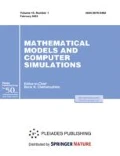Abstract
This paper presents a modification of the stochastic cellular automaton-based version of the “power–society–economics” model that describes the dynamics of power distribution in a hierarchy taking into account social and economic processes and corruption in the system of power. This approach allows the model to incorporate a number of new factors, including transport communications among municipalities and regions. The basic principles of the model are presented, a simulation system is constructed, and a number of numeric experiments unimplementable with a continuous deterministic model are conducted. Some new results are obtained, including the relationship between the power dynamics and corruption level, as well as the influence of the transport network on the dynamics of the system.
Similar content being viewed by others
References
A. P. Mikhailov, “Mathematical modelling of power distribution dynamics in hierarchical structures,” Mat. Model. 6 (6), 108–138 (1994).
A. P. Mikhailov, Modeling of the System 'Power–Society’ (Fizmatlit, Moscow, 2006) [in Russian].
A. P. Mikhailov, “The model of corrupt power hierarchies,” Mat. Model. 11 (1), 3–19 (1999).
M. G. Dmitriev, G. S. Joukova, and A. P. Petrov, “Asymptotic analysis of the 'authority–society' model in case of two stable authority profiles,” Mat. Model. 16 (5), 23–34 (2004).
A. P. Mikhailov and D. F. Lankin, “The structures of power hierarchies,” Math. Models Comput. Simul. 2, 200–210 (2010).
M. G. Dmitriev, A. A. Pavlov, and A. P. Petrov, “The 'power–society–economy' model with a slightly corrupt discrete hierarchy,” Mat. Model. 24 (2), 120–128 (2012).
A. P. Petrov and M. E. Stepantsov, “Simulation of three-tier system 'power–society' based on cellular automata,” Mat. Model. 28 (3), 119–132 (2016).
M. E. Stepantsov, “A possible modification of the discrete mathematical model of transport network dynamics,” Komp’yut. Issled. Model. 5, 395–401 (2013).
Author information
Authors and Affiliations
Corresponding author
Additional information
Original Russian Text © M.E. Stepantsov, 2017, published in Matematicheskoe Modelirovanie, 2017, Vol. 29, No. 9, pp. 101–119.
Rights and permissions
About this article
Cite this article
Stepantsov, M.E. Simulation of the “Power–Society–Economics” System with Elements of Corruption Based on Cellular Automata. Math Models Comput Simul 10, 249–254 (2018). https://doi.org/10.1134/S2070048218020126
Received:
Published:
Issue Date:
DOI: https://doi.org/10.1134/S2070048218020126




